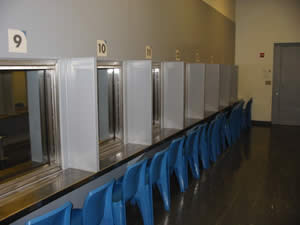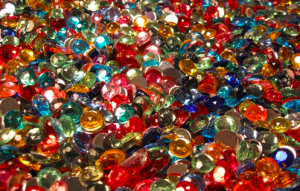I love clothes. I always have. As a black girl coming of age in the early 1990s, I was up on all the adornment trends: from asymmetrical haircuts and Cross Colours jeans to neckties and button down shirts (a la Boyz II Men). As any person who went to a predominantly black school knows, you had to come to school CLEAN! Even as twelve-year-old kids, style was our form of self-expression. It was our way of envisioning possibilities for our futures that could propel us beyond the de facto boundaries of our hyper-segregated neighborhoods. Dressing stylishly enabled us to
imagine what it would be like to be doctors, ball players, lawyers, millionaire businesspersons, or entertainers. Because of our self-fashioned “fly code,” I was always looking for the next dope outfit to wear to school.
One day, my stylish Mother came home with a white denim short set that she’d bought for me. The shorts and matching top had these multicolored, beaded tassels—“pretty sparkly things”—dangling from them. I paired the outfit with a hot pink hat (like the ones Mayum Bialik used to wear on the T.V. show “Blossom”). I borrowed my mother’s hot glue gun (this was pre-Bedazzlers), and I glued rhinestones on a pair of my ballet flats. That next week, I strutted through my junior high school’s halls in my new fashion ensemble. I was the Hip Hop Coco Chanel, and this outfit was my masterpiece! It quickly became my signature look that I reserved for special occasions.
So naturally, when my Father told me we were going to visit my older brother who was serving time in prison, I knew exactly what I was going to wear: my outfit with the pretty sparkly things! I wanted my big brother, who was eight years my senior, to be proud of the young woman I was becoming while he was away. And, to me, this outfit symbolized not only my sartorial innovation but also my maturity and professional promise.
I had never been to a prison before. I was terrified. But, I put aside my fears so I could visit my hero. After riding in the car for what seemed like forever, we pulled into the prison’s visitor parking area. My heart began to pound; I could feel moisture forming on my palms. I wondered: “Would my brother recognize me? What was his life like in prison? Was it like the film
South Central? Was my Brother like O.G. Bobby Johnson? If I go in, will they force me to stay…forever?!” All of these thoughts whizzed through my twelve-year-old brain as we approached the facility. The one thought that did
not occur to me was that I might not be able to get
into the prison because of what I chose to wear that day.
Another visitor informed my Father that the guards might not let me in because my pretty sparkly things violated the visitors’ dress code. I was crushed. The very outfit that I’d picked out to impress my big Brother with might be the very thing that kept me from even seeing him. My outfit was an affront to the prison industrial complex. And, the prison system responded by attempting to stifle and confine my creativity—reflected in the pretty sparkly things on my garment—the same way it had those of the millions of men and women held captive behind its bars. Tears welled in my eyes. I felt guilty that after driving nearly two hours to the prison, my Dad would not even get to see his son. I felt like I had wasted his gas and his time simply because I had to wear
this outfit.
My father and the other adults began brainstorming as to what could be done about my clothes: perhaps they could give me someone else’s t-shirt to wear so that only the pretty sparkly things on my shorts would show. Maybe someone could wait in the car with me while my Father went inside…“So much fuss over a few pretty. sparkly. things.” I thought. Finally, the prison authorities decided I could go in. I could keep on my outfit, and I could go into the prison. We got to see my Brother, who put on a happy face for us despite the fact that he was likely ashamed that we had to visit him under such circumstances. I hugged him, and beamed with pride (though a little less brightly) as I showed off my outfit. I left the prison knowing that something in me had changed; I had lost a bit of my innocence that day. I had been exposed to a type of cruelty that I could not articulate at the time. I never visited my brother again. And, once he was released, we never discussed his stint in prison.
I recently shared my story with activist Lois Ahrens, who runs the
Real Cost of Prisons Project, based in Northampton, Massachusetts, and she helped me put my personal experience into a broader context. I asked her, “Why did this happen? Why are guards so worried about what people wear?” Ahrens said:
Guards have power and prisoners and visitors have none. Everything a guard does reminds a prisoner or visitor of that dynamic… We are all presumed guilty because we are visiting someone who has been found guilty… Every visitor is suspect therefore whatever a visitor does or wears is suspect.
She then gave me a list of clothing and adornment items that have been banned from Massachusetts’ prisons:
Tassels Cargo pants
Open-toed shoes Bobby pins
Barrettes Earrings
Sleeveless shirts Underwire bras
Zip-front shirts Shorts
Baggy or tight clothing Clothing w/ many pockets
Hoodies Revealing or sheer clothing
Bodysuits of any type Wrap around shirts
This list represents the literal policing of people’s dressed bodies. The guards have the sole discretion to enforce these dress codes, and the list of banned garments varies from state to state. If you challenge a guard’s decision about your clothing, you could lose your visitation privileges for a year or more. These adornment regulations are part of a larger, problematic set of visitor body politics. Loved ones are subject to intrusive body searches, which can include: scanning; wanding; removing shoes, outer shirts, and belts; looking under your collar; examining your hair and mouth; and having search dogs sniff you. This process is only slightly less invasive than the full-body searches the prisoners are subjected to before they enter the visiting area.
The reality is that most people, like my family, do not know the rules regarding “proper” attire while visiting prisons. Nor are most people trying to sneak contraband to prisoners in their garments. Ironically, it is often the guards who operate smuggling rings (see
here and
here). Most people are simply trying to visit their loved ones, trying to make their family members
feel their love through the prison’s Plexiglass windows. During our conversation, Ahrens noted the paradox between prisons’ treatment of loved ones and their stated views about the importance of family visits. She told me, “Every state claims it values ‘family reunification,’ yet every state makes visiting as degrading as can be imagined.” Ahrens is currently engaged in a battle with the Massachusetts Department of Corrections (DOC), pushing the DOC to change its policy regarding using search dogs during the visitor screening process.

Families often have to visit with their incarcerated loved ones through a Plexiglass window
But, what the fight for the humane treatment of prison visitors needs most is people willing to share their stories. Ahrens states, “Visiting a prison or a jail is traumatizing for everyone, which is why it is so important to do it and good to talk about it since there is so much stigma and shame with having a loved one in prison…which helps keep [the structure of power] in place.”
I’d pushed my traumatic visit to the prison into the recesses of my memory, until I started organizing this mass incarceration forum. At twelve years old, I did not have the language with which to articulate my trauma or to push back against the system. But, now I understand the power in speaking out about these issues. Incarcerated folks—regardless of whether they are innocent or guilty of the charges for which they have been convicted—
belong to someone. They are loved. And, their loved ones deserve to be treated humanely when they visit. This essay was very difficult to write because this experience was so personal, and family dynamics can be hard to discuss in an open forum. But, it is important to illuminate how mass incarceration affects families. We are invisible victims of the prison system. I hope my story compels others to share their experiences and join in the fight against the prison industrial complex.
*This piece is written in loving memory of my big Brother who died tragically on December 16, 2012.
****
Get involved with the Free Mumia Movement
Connect with the Bring Mumia Home campaign on
twitter



This piece invoked a pain in me I haven’t thought about for some years. I used to visit my father in prison. It was a traumatic experience. I think I’m most horrified by the light that would come on that let people know someone was coming to the visitation area. It was white and cold. It sanitized my excitement to see my father.
One particular visit I remember fussing with my grandparents about why I couldn’t leave a picture I drew and painted for my daddy with him. My folks had to argue with the guards just to let me bring it in so he could see it. I worked hard on that piece. And it broke my heart – probably not as much as my daddy’s – that I couldn’t leave it with him.
Thanks for this piece and bringing a sense of humanity to not only the prisoners but the family that has to jump through hoops to see them.
prison. She felt humiliated because they would not let her wear it during the visit even after she removed it for inspection.
I was a volunteer chaplain at a prison (my goal was to just be with people not to convert or be with “offenders” or to have any religious agenda—but to be with them) for 2 years and I would routinely show up and the guards at the desk would pretend they couldn’t find the paperwork to sign in. Despite the fact that I could see it- in plain sight behind the guards.
I was being policed, reminded who was in charge and controlled and recall being aware that this was the encounter with the system that inmates had all the time. I didn’t know how I would control my rage if I were to encounter that all the time….
Thank you again for your wise words, profound work and inspiration.
-R